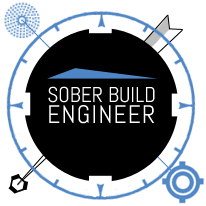Ever Onward [C.H.M.]!
I went to the Computer History Museum this weekend, in part, to work on a mini-project.
Since it had been the first time I’d been there in probably over a year, I was excited to see what had changed.
Ever Onward I.B.M.! |
I was totally blown away by the transformation.
My first couple of visits to the Museum made its roots quite obvious: housed in an old SGI building, the purple was pervasive, but that was about all that remained. They had exhibits… sort of. The actual “museum” consisted mostly of their “visible storage” room.
It basically looked like a warehouse of old junk—one of the exhibits was famously covered in bullet holes1—that someone had cut a path through. The layout was well-suited to illustrate the progression of computer history, from abacuses to today’s video game systems.
But even for a geek like me who was genuinely interested in artifacts like racks of vacuum tubes, the room really didn’t come alive unless you went on a docent-led tour. (It was totally a bonus that many of their docents were ex-employees of the various companies’ whose products were on display, and had many personal anecdotes that one would never hear in another museum2.)
But if you weren’t lucky enough to have that experience, it could get kind of… well… boring. The significance of all of the awesome artifacts they have wasn’t immediately palpable.
That has been totally addressed in the last year!
We got to the museum too late for a docent-led tour this visit. I had expected to be dumped in the warehouse-esque room again, and started trying to dig up from my memory what I had gleaned during my two earlier docent-led tours. But to my pleasant surprise, this visit started with an introductory video that not only did a great of setting the stage for what we were about to experience, but pleaded the case why the Computer History Museum as an institution is important.
We then walked into the exhibit hall, and I was utterly blown away.
This concept of the path through the history of computing remained, but that was about it. I recognized many of the exhibits from my previous tours, but they had been set on display, professionally lit, and had tons of placarded information surrounding them. I would have loved to have had a docent led tour, but the lack of one no longer translated to a difficult-to-impossible to digest set of artifacts and a disappointing visit.
While I was totally blown away by these positive changes, there were still a couple of things I hope the museum will address:
- It always bothered me the discussion on IBM’s rise as a business omits the “minor detail” of their involvement in the Holocaust. None of the docent-led tours ever mentioned it, and I didn’t see a display that made reference to it… which is odd, since there were at least two displays discussing how wonderfully effective the “C-T-R machines” were at the United States census.
To be fair, during IBM’s recent 100 year celebration, they “kinda forgot” about it in the review of their corporate history as well, so… the Computer History Museum is in… well… company… - Ditto any discussion of the environmental impact of early chip-makers’ activities; this is especially ironic given that most of the land surrounding the museum had long been superfund land, because Intel, IBM, and Fairchild Semiconductor dumped the industrial acids and heavy metal runoff in the Valley’s backyard for years.
I understand these topics are hard to address, especially since the museum gets a lot of donations from these companies3, but they’re a part of history and I can’t imagine a better institution to fairly tell those stories in the context of the history of computers and the Silicon Valley than the Computer History Museum.
With these recent changes that make the Computer History Museum feel “all grown up,” omitting difficult topics seems passe and detracts from the Museum’s (hard earned and well deserved) credibility.
Despite these minor areas for improvement I still consider the Computer History Museum a gem of Silicon Valley, and feel a personal connection to it that many feel to SFMOMA or the Academy of Sciences.
The Museum will remains one of my top recommendations for anyone visiting the Bay Area, but with these recent improvements that really bring the history of technology to life, being a hard core geek is no longer a prerequisite for admission to a fun, engaging time.
_______________
1 Someone’s son thought it looked useful for target practice
2 I really fear these will be lost to time; I would love to see the museum undertake a spoken history project to collect interviews with these individuals
3 Of both money and artifacts

Penciled in for future trips to your lovely little stretch of CA.